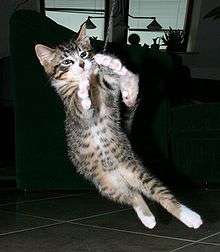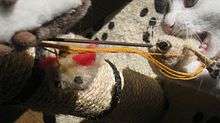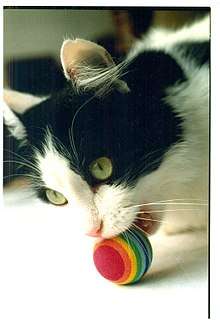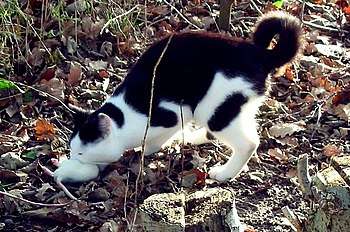Cat play and toys




Cat play and toys incorporates predatory games of "play aggression". Cats' behaviors when playing are similar to hunting behaviors. These activities allow kittens and younger cats to grow and acquire cognitive and motor skills, and to socialize with other cats. Cat play behavior can be either solitary (with toys or other objects) or social (with animals and people). They can play with a multitude of toys ranging from strings, to small furry toys resembling what would be prey (e.g. mice), to plastic bags.[1][2]
Nature of play
Predation

Since cats are meat-eating predators, nearly all cat games are predatory games.[3]
Prey are fearful of predators. Predators often encounter prey that attempt to escape predation. Prey that move towards the cat with confidence may be exhibiting an aggressive defensive posture. Cats often play with toys that behave more like fearful prey trying to escape than toys that mimic more confrontational prey.
Success rate
Success rate is important in play. A cat that catches its prey every time soon gets bored, and a cat that never gets it just loses interest. The ideal hunting success rate is around 1 in 3 to 1 in 6. Capturing prey at this rate generally maximises a cat's interest in the game.[4]
Precautions
Play is about predatory behaviour, and a highly excited cat can cause minor injuries in the excitement of the moment. With most cats, it is wise to keep playthings at least 20 cm (8") away from fingers or eyes and avoid encouraging a cat to eat inedible toys. If playing with a human's bare hands, a cat will generally resist using its claws or biting too hard, but a cat that becomes extremely excited may accidentally inflict injuries to its human playmate in the form of light scratches or small puncture wounds from biting too hard. Cats' claws and mouths can contain bacteria that can lead to infection, so it is wise to clean and treat any wounds with an antiseptic solution and seek professional medical services if there is reason to believe that the wound has become infected.
Food
Catching and eating are two closely related but separate activities. Domestic cats often store caught food for eating later. Eating happens when the game is over, so incorporating food into hunting games tends to end the interest in play. Hidden treats helps engage cat's senses such as sense of smell and can be a form of play which enables them to utilize their searching skills. This idea of treats linked with play helps cats form the association that treats signify happy behaviour.
References
Further reading
- Hall, Sarah L.; Bradshaw, John W. S. (June 1998), "The influence of hunger on object play by adult domestic cats", Applied Animal Behaviour Science, 58 (1–2): 143–150, doi:10.1016/S0168-1591(97)00136-6 .
- Johnson, Pam, How to play with your Cat (PDF), SF/SPCA, archived from the original (PDF) on 2007-10-16, retrieved 2008-01-12 .
- Animal Behavior Center: Cat Behavior: Play aggression, ASPCA, archived from the original (– Scholar search) on 2007-12-13, retrieved 2008-01-12 .
- Animal Behavior Center: Cat Behavior: Cat's play, ASPCA, archived from the original (– Scholar search) on 2007-12-29, retrieved 2008-01-12 .
- Florian Gekeler; Kei Shinoda; Georgios Blatsios; Annette Werner; Eberhart Zrenner (February 2006), "Scotopic threshold responses to infrared irradiation in cats", Vision Research, 46 (3): 357–364, doi:10.1016/j.visres.2005.06.023, PMID 16081127